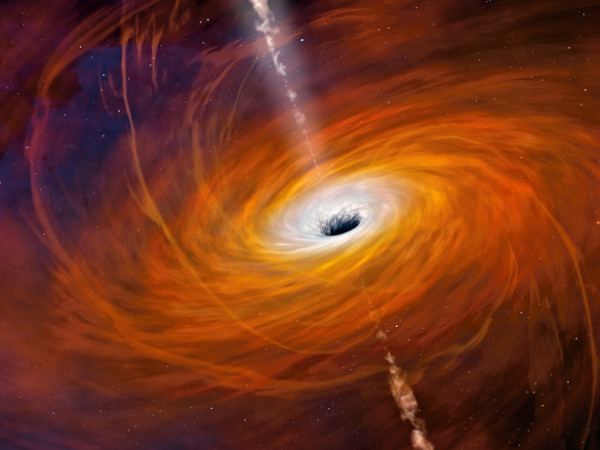“Nobody ever did, or ever will, escape the consequences of his choices.” -Alfred A. Montapert
You might not think of falling into a black hole as a choice, but in the case of this week's Ask Ethan, someone is choosing to explore exactly that!
 Image credit: original unknown, retrieved from http://mondolithic.com/.
Image credit: original unknown, retrieved from http://mondolithic.com/.
Imagine, if you will, taking a solid object that's completely outside of an event horizon, of choosing a very massive black hole with minuscule tidal forces at that location in space, and then just barely pushing a tiny piece of that object over to the other side of the horizon. Would you be able to pull it back out again?
 Image credit: Mark Garlick, via http://ngm.nationalgeographic.com/2014/03/black-holes/finkel-text.
Image credit: Mark Garlick, via http://ngm.nationalgeographic.com/2014/03/black-holes/finkel-text.
An interesting situation to explore, but I'm not about to let someone get off easy! Dive in to the possibilities and impossibilities of black hole escape on this week's Ask Ethan.
- Log in to post comments

Other explanation, why nothing can escape from the black hole, is the time-space distortion at a event horizon.
For the external observer, the time at event horizon stops and nothing actually falls into the black hole, it gets only closer and closer. So for external observer, nothing can escape from the black hole, because noting have actually fallen into it.
Technically, you can't get away from the sun either: your escape from the sun's gravitational escape would require infinite time to reach the infinite distance required to get it to zero.
The escape of the sun's effect is theoretically possible, though, whilst escape from WITHIN a black hole is not, not even infinity will help you since you can't get anywhere near it. You can still get a huge distance away, as far as you arbitrarily like, like the arrow to the tortoise in Xeno's paradox, but not to infinity.
The size of the event horizon for an observer a thousand light years away from a black hole, corrected for SR distances of the observers, is, however, larger than the size calculated by someone in a spacecraft orbiting near the black hole, but still outside by the terms of the more distant observer.
Light can get to the nearer observer from the same distance from the geometrical location of the black hole with excess energy. Therefore light from further in can get to that point with less excess energy. Therefore there is a closer point to the black hole from which light just cannot manage the distance. And that's the event horizon.
This is different from the Schwartzchild radius, which is what people generally mean by "event horizon". Its the same thing for an observer at infinity, and for most people light years away, the difference is negligible.
Ethan, instead of thinking of someone inside being pulled out by someone else on a strong piece of string,think of a composite body whose centre of gravity is outside the event horizon, but whose physical extent is nonzero and therefore it extends part of itself inside. Making the assumption that the tidal forces are not so severe as to rupture any part of the chemical binding of the object.
How far away from the black hole could that body get?
I agree *definitionally* it cannot be infinity, but in practice, we never CAN get to infinity, any distance we can consider is just as far away from being infinite that there is no difference between that and never moving away at all.
So a composite body. A steel ball bearing. 1 cm across, 0.4 cm from its centre to the event horizon of Cygnus X1. Assume it's 15 million solar masses. Assume that the ball bearing is given kinetic energy equal to its rest mass energy.
How far away can the ball bearing be moved away from Cygnus X1.
What I propose is that the ball bearing has to be closer to Cygnus X1 to be that close to the *event horizon*. But if "event horizon" means this construction:
http://en.wikipedia.org/wiki/Schwarzschild_radius
The result can be calculated quite simply. And it's not zero distance traveled.
According to the URL mentioned above (http://en.wikipedia.org/wiki/Schwarzschild_radius) would it be possible to state that a black hole is condensed matter with an extremely large amount of matter and volume? If so, according to Newton’s Universal law of Gravitation, it would be possible to make the assumption that the closer two objects are to each other, the stronger the gravitational attraction between them. This would mean that if an object is placed infinitely nearer to the Schwarzschild-radius, there would be an infinitely stronger force of attraction on the object, i.e. it would take infinitely more force, to counteract the forces of attraction, so that the object can be pulled away from, or out of, the area beyond the event horizon.
UP Student number: 15086187
I have 2 comments/questions:
1) how can it be that light cannot escape a black hole just inside the EH if the force of gravity is less than that of earth?
2) on a different subject, how is it that we have an exploding singularity at the BIG BANG target than a black hole? If it takes a certain sufficiently large mass to create a black hole. Certainly, all the mass that would become the universe would suffice. Or is there a point at which a black hole reaches a maximum? But this has its problems too. Why does it not just burn as a star......very quickly I'd think though.and then what..... a black hole?
If a black hole is powerful enough to suck in all matter in a certain radius of it, it would be virtually impossible for the experimenters not to get sucked into the black hole themselves. Therefore, I think it is not possible to be able to pull something back out of a black hole because one is most likely to be sucked in as well.
15016961
The article mentions something about the black hole being a region of dense gravity. Has it been experimentaly measured? 14032164
In a manner of speaking, I think you could crawl out of a black hole without violating any laws but it requires the proper set of circumstances.
I'm calling this the Denier Loophole.
You start by making a black hole. I'm thinking a black hole about the mass of Earth would be perfect. You'd get a black hole with a schwarzschild radius of 8.7mm or about the size of a peanut.
Next step is to accelerate the black hole to a speed as close to c as you can manage. The faster the better.
Lastly you need to have something to put out in front of the black hole but off to one side and stationary relative to the inertial reference frame of the black hole before it was accelerated. It would be good if that thing had thrusters.
Here is how it works:
The schwarzschild radius is set by the relativistic mass of the black hole. You have to dump an outrageous amount of energy into an Earth-mass black hole to accelerate it to a speed anywhere near c. That energy shows up in the mass of the system and so to someone stationary to the starting frame that black hole now has a schwarzschild radius of thousands or even millions of miles.
If the probe is 'thousands or even millions of miles' off to one side, then it will still cross the 'point of no return' and enter the relativistically very fast black hole. However, as the gravity of the black hole accelerates the probe towards the singularity, the inertial reference frame of the probe starts to match the inertial reference frame of the black hole. When that happens, the probe in the new inertial reference frame sees the schwarzschild radius of the black hole shrink down to the size of a peanut, and the probe is thousands or even millions of miles from there.
TA-DA!!!!!!!
Into the black hole, out of the black hole: The Denier Loophole.
The problem you have is that there is going to be no difference between accelerating that earth-sized black hole to "near c" and throwing it bear something that was at the same inertial frame, and accelerating that something to the same relative velocity.
It's a good attempt, but it is also an illustration of how you need to be skeptical of your own ideas. Look for how they COULD be wrong first.
The original meaning (and still the only one that makes sense for the "exception proves the rule" meme) is not to show it's real, but to test it to destruction, if necessary.
Old armourers would try to break their armour with some genuine hit that should test if the armour would stand up to any concievable impact in battle, after which it would be "proved" (given a stamp of proof).
You would NEVER see any armour of proof with that seal and NOT without some sodding great big battering on bits of it unless the mark was fake.
Look for how your assertion is wrong. If you can't find one that sticks, nobody else can come up with that counter. If someone comes up with a new one, test it for being correct, then test for it being INcorrect. They may have made a mistake or error too.
Science skepticism is a mobile, fluid stance and always willing, indeed usually all the time moves, whist dogmatic contrarianism never moves except for its goalposts. They never stand still.
bear == near
Uh, they'd have to be WITHIN that radius first.
Outside that, there is no sucking. Within that radius, still no sucking. You can orbit a black hole within its event horizon just fine. You just can't get out to infinity (or less, depending on how deep in your orbit is).
There's no "suck". You don't call gravity of earth "Something that sucks you down to the ground", do you.
The gravity of a black hole is no different.
Completely suck free.
It is in a deeper hole. It's like saying why are you stuck in a nine foot deep hole when you got out of that nine inch pothole just fine.
It didn't explode.
It expanded vastly fast. Faster than light (because it was space changing, not things moving in space, which is limited to light speed). Therefore, though the total force felt was at one time too big to escape, inflation meant most of that universe was invisible to one part (any one part) and could not affect that part of it. Which meant there was no "black hole singularity" problem you describe.
That's why the two memes "nothing escapes a black hole" and "the universe exploded from a single point" are good for vague understanding, but if you want to go querying about the science involved you need to get a better understanding FIRST.
They aren't infinitely close. The objects are almost infinitesimally larger than the Schwartzchild radius apart.That, for any actual mass, is much larger than infinitesimal. It's only infinitely small for infinitely small masses, whose gravitational attraction is likewise infinitely small.
Which for the force of attraction MAY become non-zero, or even speculateively infinite.
The only way to find out is to have the CORRECT equations for gravity on a quantum scale and to then solve them for infinitesimals.
@Wow #10
The logic you are using to discredit the Denier Loophole is the same as used in the Twin Paradox thought experiment. If that logic holds then Special Relativity has a huge problem. I'm cool with it either way but you should know that you're cutting down Einstein, not just me.
"If that logic holds then Special Relativity has a huge problem."
No it doesn't.
And your "loophole" is bollocks. Already been dealt with.